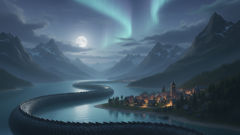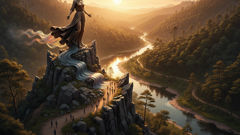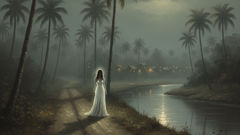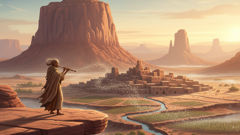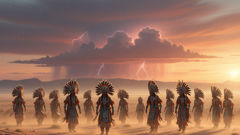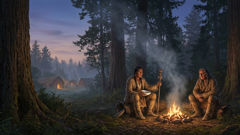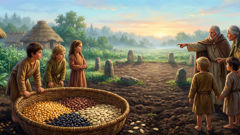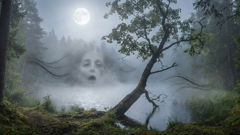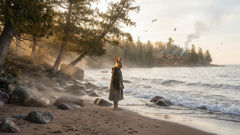Introduction
Along the ragged coastline where Norway's fjords breathe cold mist and the basalt cliffs meet an ocean older than memory, the name Jörmungandr carries like an echo. Fishermen who mend nets beneath the northern lights still tell of a shadow beneath the waves that moves with the slow certainty of a winter's advance. In the oldest sagas it is said that Loki, reckless and brazen, fathered a brood of wonders and terrors that would shape the fate of gods. Among them, the child who would grow so vast that the sea itself could not contain him: Jörmungandr, the Midgard Serpent. He swam out from the deep and widened his coils until he could wrap the world in his circumference, biting his tail to bind the horizons together. This image—of a snake that encircles earth and grasps its own end—became for the Norse a mirror for cycles: the way storms return, how seasons come back around, and how endings fold into beginnings. Yet Jörmungandr's story is not merely cosmic geometry; it is the living tension between ocean and sky, between hunger and bound restraint. On calm days he is the unseen hold beneath a child's wooden skiff; on storm nights he is the thunderous rumble you hear before the rain, the sea rolling like the breath of something immense. Families by peat fires would hush children with the thought of the serpent's coils sliding past distant islands, and skalds would speak his coming as both omen and inevitability. This tale will travel those currents of salt and story: from the iron-forged halls of Asgard to the fishermen's cottages on the edge of the world, from the serpent's birth in deception to the final, earth-shaking moment when he and the thunder-god meet. Along the way, we will listen for what a culture holds when it imagines a creature that measures the world by its own length—how fear, wonder, restraint, and longing gather where gods and seas conspire.
Origins and Oaths: The Birth of the Serpent
In the beginning of the sagas, before the first hearth was lit under a thatched roof and before the runes were sung into being, the worlds were raw and unshaped. From Ginnungagap's yawning silence—where ice and fire met and quarrelled—came the ancestors of gods and giants. Loki, ever both wit and mischief, belonged to that lineage of boundary-crossers. He was a figure of uneasy grace at the court of the Aesir: cunning as a fox, restless as a gale, and marked by a need to unsettle order. His liaisons brought forth offspring that were less simple children and more manifestations of the world's caprice: a wolf whose jaws would one day devour sun and moon, a woman of such cold that the oceans chilled at her approach, and a serpent that began as a whisper in deep water.

Jörmungandr's story begins not in a cradle but in a calculated act. Freyja's table was set, and the gods were held in uneasy alliance. Odin, thoughtful and far-sighted, sought to secure the human realm—Midgard—against the chaos that circled like gulls at a whale carcass. Some tales say the gods cast Jörmungandr into the sea to keep his danger at bay; others say it was Loki's own restlessness that sent him sliding into the depth. Either way, the serpent was submerged and grew. If one imagines the sea as a long memory, Jörmungandr grew into that memory: his girth absorbing tides, his length swallowing the songs of whales. He became a living perimeter. To the Aesir that meant a creature who could be an ally—binding the seas to a comprehensible border—and a threat, because anything that spans the world's edge can undo the world by simply choosing to uncoil.
The metaphor is deliberate. The Norse saw their geography in living terms: islands as ribs, fjords as wounds, and the sea as an entity with appetite and moods. Jörmungandr's encirclement of Midgard maps onto that sense; it explains how the sea can both preserve and consume. In some stories, the serpent sleeps, its breath a long fog that keeps storms away; in others, he tests the gods, nudging the edges of their knowledge. When Thor, god of thunder and protector of humankind, encountered the serpent in his youth it was under a different name and shape: a great fish that tugged at a boy's line. Thor's first contests with the serpent—fisherman and fish in a skiff, iron and scale against each other—was at once sport and omen. That day, Thor nearly lost his hammer and his composure. Later, when he would meet Jörmungandr again, each confrontation would resound with the memory of that hauling line, a child's realization that the ocean contains something that will not be bartered away.
But the serpent's origin is more than a plot device; it set the rules for a cosmos where the perilous and the protective are entangled. For villages built upon the edge of breath and surge, Jörmungandr represented a boundary against deeper chaos and a reminder that boundaries are, at heart, fragile. The sea can be reasoned with, and yet it holds other minds. To have the serpent coiled around Midgard was to accept a neat and terrible logic: life is girded by a force whose scales measure hours and whose hunger measures seasons. Songs written for the hearth tell of oaths the gods took—vows to keep the world in order, vows to watch the serpent—and this vigilance binds the tale to human concern. The people who told this story needed it to say: the world is held together, but tenuously, by those who watch and by those things we cannot watch.
The serpent's presence permeated the Norse imagination in other forms as well: carved into runestones, coiled on shield-edges, and braided into the hair of mythic trees. Yggdrasil's roots drink the waters through which Jörmungandr swims; their myths are braided like a rope meant to hold a great weight. In the quiet hours, fishermen would cast their nets and feel the tug of currents as if fingers of a sleeping giant passed below. Mothers would hush their children with the story of a snake who kept the world's oceans from running amok. The narrative's resonance is not merely symbolic but experiential: living by the sea meant that you carried the serpent in your bones. It explains why a culture with few steady harvests and many voyages would compose such a creature into its origin myth. It had to be vast. It had to be awful. It had to be necessary.
That necessity becomes a motif throughout the sagas: that growth often carries consequence, and that containment requires continuous attention. Jörmungandr's coils are thus both geometry and ethics, a lesson in how the natural order imposes itself on human plans. But myths never remain didactic alone. They acquire texture: the smell of kelp on a storm-soaked rope, the crack of ice when the serpent shifts, the way gulls fall silent when he surfaces. In the coming stories, we will witness a sea that remembers and a serpent whose very circumference marks the limits of human knowledge. We'll follow Thor's repeated reckonings with the giant, the gods' uneasy bargains, and the slow tightening of a fate that names itself Ragnarok. All of this begins with an origin that is, by turns, a wound and a promise: Jörmungandr's birth binds Midgard to the sea and the world to a fate it cannot quite see.
Coils of War: Thor, Fate, and the Unraveling
If Jörmungandr's birth places him at the center of the world's shape, his life writes him into its most violent lines. Few encounters are more storied than those between the thunder-god Thor and the serpent. Thor is not merely a warrior; he is the guarantor of human stability, the god who walks between the villages and the wild. His hammer, Mjölnir, is both instrument and symbol: it restores warmth, it secures oaths, and it breaks the things that would eat the common day. For the Norse, Thor and Jörmungandr represent two modes of the world—the force that defends and the force that threatens that defense. Their meetings are not random; they are structured confrontations that test the borders of order.
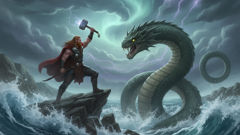
One of the most famous episodes tells of when Thor traveled in disguise to the hall of the giant Utgard-Loki. In the giant's court nothing is what it seems: illusions confound strength and guile. Yet even amidst that deceit Thor's might could scarcely be contained. It is said that when Thor attempted to lift the giant's cat as a trial of strength, he nearly breached the world. The cat was, in truth, Jörmungandr in a stretch, the serpent disguised to test the god. Thor could not lift the entire world because the serpent's circumference held it down; he strained and drew breath like a man burning with cold and rage. That moment refracts the myth's logic: strength and containment are reciprocal; to test one is to reveal the other. Thor's encounters reveal something human about the gods themselves—they cannot escape the shapes the world imposes upon them.
Another tale places Thor upon a small fishing boat called Bilskirnir with the giant Hymir, who, for reasons both practical and ominous, agrees to let Thor fish. As Thor hooks the line and the water hushes, what rises is not a mere fish but the spine of something enormous. The sea bulges as if the world itself had inhaled. Thor draws with all his might; he readies Mjölnir overhead; the world trembles in the axle of the struggle. In some versions Thor's friends lose nerve, and Hymir, terrified, cuts the line to spare the world a tantrum of thunder. In others, Thor nearly drags the serpent to the surface and the clash rings across sea and sky. These stories serve as prelude; they are the first notes of an unplayed song, the echo that tells listeners what the final movement might sound like: metal and scale, hammer and venom, the end of one age and the beginning of another.
The Norse did not imagine fate as mere punishment; it was a pattern to be read. Ragnarok—the twilight of the gods—was not a moral judgment only but a cosmic reordering. In that last battle, Jörmungandr uncoils with finality. His venom fills the air and the seas rise in a madness of surge. He and Thor meet in a duel that is both personal and archetypal: the god whose duty is to keep mankind safe grapples with the creature who encircles it. The clash is as inevitable as tide and moon. For the Norse, this collision did not merely mean destruction; it meant transformation. The end of one age births another in mythic terms, and the serpents and gods yield a world cleansed and remade. This belief tempered the fear with a fierce beauty: there is meaning in endings, and even monstrous things play a role in creation's circular design.
The image of the serpent biting its own tail—an ouroboros of sea and fate—takes on new resonance here. It becomes not only a seal but a clock. When the seal breaks, the world will disclose what it withheld: storms will speak of old debts, and the air will carry the scent of something elemental. The poets—skalds who travel between halls—spoke of Ragnarök as both prophecy and instruction. They told of the children of Loki, the wolves that chase sun and moon, and the serpent that shakes the seas. They told too of human courage, the small and stubborn light of hearths that persist even when the seas boil. In their verses you feel the fullness of a people who live under weather and fate: they make pacts with both, they craft nets and oars and names to steady themselves. This is the human thread that winds through the serpent's coil. It is not only about gods; it is about fishermen, mothers, and boys who learn to fear and respect the ocean.
The consequences of Jörmungandr's existence ripple into how the Norse conceived war, weather, and wisdom. Storms are read as messages; enigmas are accepted as part of life. Even the decorative art—drakes and serpents carved on ships and swords—recalls the serpent's presence as both guardian and threat. When a longship's prow bears a serpent's head, it says: we understand the sea's double face. We will go out anyway. That tension explains why the tale endured, why it was retold in hearth-halls when children grew restless and when warriors needed a reason to accept danger. The serpent shapes not only physical borders but moral ones: it asks what lengths a people will go to keep their lives together, and what sacrifices are tolerable for the promise of continuity.
As the world tightened toward its end, the encounters between Thor and Jörmungandr became the axis upon which stories turned. The final meeting is a culmination—years of small struggles and near-misses folding into a single, harrowing confrontation that will break and renew the world. When the two meet, neither yields easily. Thor strikes, and the serpent's venom burns into him; Jörmungandr coils and presses his weight against the seas. Both collapse in a terrible beauty, an exhausted cessation of motion that leaves the world altered. Yet myth insists on regeneration. After the tumult, a few survivors remain, and seeds of the future germinate among the ruins. The serpent's coil has no absolute finality; its story concludes by opening things anew. Within this contradiction, the Norse found a meaning that allowed them both to dread and to embrace the inevitable: the end is terrible and yet it is part of the long and stubborn weaving of life.
Conclusion
Myths endure because they answer questions that keep returning: why the sea will not be tamed, why the summer recurs and then dies, why human borders are both practical and precarious. Jörmungandr's image—vast, encircling, and biting his own tail—functions like a compass and a caution. It measures the tension between what we can hold and what holds us in turn. In the slow economies of the Norse worldview, the serpent's coil is an ethic and an ecology: it tells people how to set their nets and how to say prayers; it cautions rulers about pride and comfort; it instructs poets on the cadence of endings. Even now, on cold nights when the sea smells of iron and the lights of villages gutter, the old stories persist. They are spoken by fishermen trimming sails, by children who are both frightened and delighted at the idea of something so vast living beneath the waves. They persist because a world that remembers a creature like Jörmungandr is a world that understands the reciprocity of protection and peril. The serpent is a monstrous guardian and a reminder: the boundaries we draw are real, but they require constant tending. In the coiling and uncoiling, in the calm and the storm, the world keeps moving, and the story keeps being told. Where once the Norse made sense of a dangerous ocean with song, we now read their images as both cultural artifact and living lesson. Let that lesson hold: to reckon with vastness is to recognize your smallness, and in that recognition there is an honest courage.

